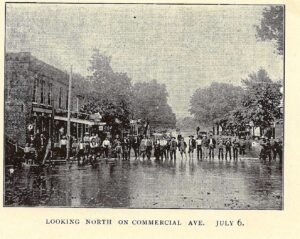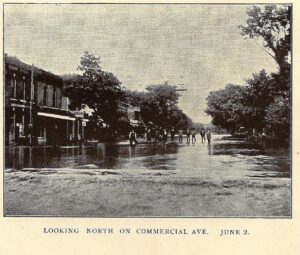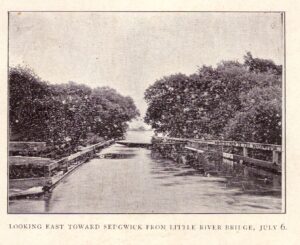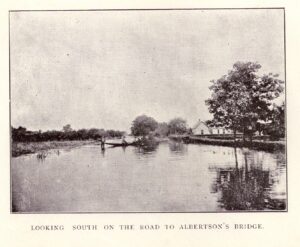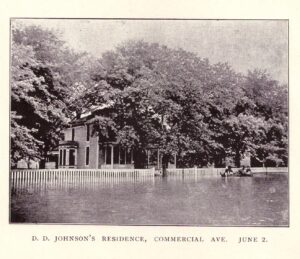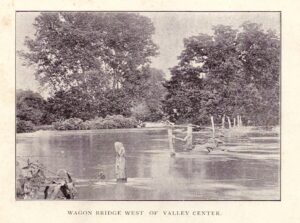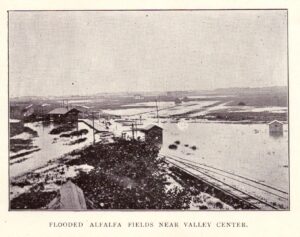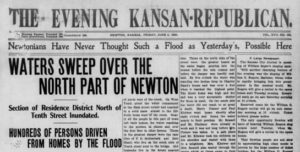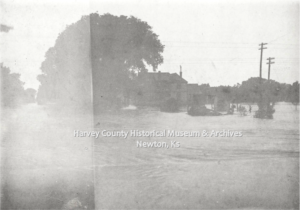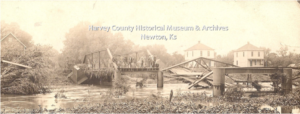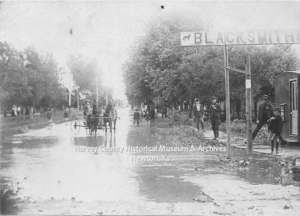by Kristine Schmucker, Archivist/Curator
Previously posted August 8, 2013, No Place Like Newton, Even if it does have a Sand creek”: The 1904 Flood
“Sand Creek, the despised and ridiculed, spread over its banks and overflowed the north end, for once a raging, destruction dealing current.”
“The Flood-gates Were Opened”
 |
| Headlines from Evening Kansan-Republican, June 2, 1904 |
 |
| 1904 Flood Newton HCHM Photo Archives |
The next edition of the Evening Kansan-Republican headlined with the statement that “Newtonians Have Never Thought Such a Flood as Yesterday’s Possible Here.”
“The unexpected has happened and Newton has had its first experience with flood conditions. During the floods that prevailed last spring in the eastern part of the state, Newtonians found satisfaction in the thought that their own town, of all others, was safe . . . being far from any river and apparently as high and dry as a town could be.” (Evening Kansan-Republican, June 3, 1904, p. 1)
 |
| Headlines from Evening Kansan-Republican June 3, 1904 |
Bridges were washed away. The Tenth street bridge washed out and floated downstream striking the Ash street bridge. Both were a total loss. Also heavily damaged were the bridges on Main street and Broadway.
Many were unexpectedly trapped as their homes became islands because “it seemed so improbably that the water could possible reach to such a height.” Rescue workers with “hacks and wagons . . . rescue men on horses” all worked to get everyone to safety. In some places the water was so deep that it reached “almost to the horse’s head” and wagons could not be used.
 |
| June 1904 Flood Bethel College Graymaroon, Bethel College Yearbook, 1917 HCHM Photo Archives |
Train service was also delayed, stranding passengers at Emporia and Strong City. Track washed out in several locations including between Peabody and Florence and a bridge was washed out at Cedar Point.
“Everybody has a story to tell:” Stories from the Flood
“Such is the irony of fate that while there were many chickens and pigs drowned, one lot of pigs, which had been especially obnoxious to the neighbors were every one saved.”
“At Rev H.R. Voth’s home, No. 1211, the water was four inches above the lower floor. The carpets are ruined.”
“One of the worst sufferers was James J. Norton at No 1222 Main. Mr Norton had just moved into the house, having installed the last load of his goods at noon . . . yesterday. . . .Mr. Norton got the family out. The water rose nearly two feet in the house. Carpets and most of the furniture were ruined. Many pictures, books and other articles were piled on the floor temporarily which made the loss particularly severe.”
“Mr. and Mrs. Harry Trauber stayed in their house until late getting things out of danger and then waded in water waist high to dry land.”
“Mrs. Jackson staid [in her home] until the water oozed through the boards of the first floor as she walked over them. By that time the water around the house was very deep and the work of rescue was dangerous.”
Note: According to two “old settlers”, A.B. Gilbert and W. J. Puett, there had only been two other times Sand Creek had flooded to this extent – in 1877 and 1871 – based on their observations.
The flood on June 2, 1904 was the first major flood to occur in Newton. The rainfall, measured at 4.10,” came in a short amount of time. Primarily affecting the north end of town, flood waters got up to 12 feet. From 4 – 9 pm, the rescue efforts were underway and there was no loss of life.
“Worst Flooding in It’s History”
Roughly one month later, Harvey County was hit with another deluge. On July 6-7, the Little Arkansas River overflowed causing major flooding in Halstead and Sedgwick.
Halstead experienced perhaps it’s worst flooding to that date with the entire easter part of the town under water. According to reports it rained for 11 pm until 4 am dropping 3 1/4 inches. From the river past the Presbyterian church had depts of two to four feet. In front of the newspaper office, the water was 3 1/2 feet delaying the printing of the paper until the next day. Despite the trials in town, the farmers along the river were affected the most. It was noted that the river rose at the rate of 2 to 2 1/2 inches an hour from eleven o’clock but had decreased to 1/2 an inch by 2 pm. It was expected that the river could rise another 5-6 inches as a result of all of the rain up stream.
 |
| 1904 Flood Halstead HCHM Photo Archives |
 |
| 1904 Flood Halstead HCHM Photo Archives |
 |
| 1904 Flood Alta Mill HCHM Photo Archives |
Sedgwick faired a bit better. By July 7, the flood waters had receded. Train service was greatly impacted with many bridges out. The weather system affected an area from Topeka to Wichita with “nearly every river in state flooding.”
Sedgwick Flood Photos July 6, 1904.
Sources
- Evening Kansan-Republican, June 1, 1904.
- Evening Kansan-Republican, June 2, 1904.
- Evening Kansan-Republican, June 3, 1904.
- Evening Kansan-Republican, June 6, 1904.
- Evening Kansan-Republican, July 7, 1904.
- City Directories: 1902-03; 1905.
- HCHM Photo Archives



